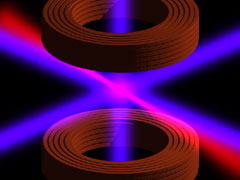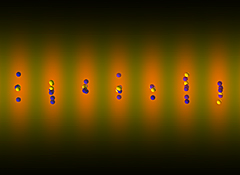Experimental Atomic
Clock Uses Ytterbium ‘Pancakes’
 |
|
NIST's new optical atomic clock uses two magnetic coils (red rings) and an optical lattice (red laser beam), as well as intersecting violet lasers to cool ytterbium atoms, slowing their motion.
Illustration credit: NIST
View a high resolution version of this image.
|
 |
The
lattice of laser beams traps small numbers of ytterbium
atoms in pancake-shaped "wells." A yellow laser
excites the atoms so that they switch between lower (blue)
and higher (yellow) energy levels.
Illustration credit: NIST
View a high resolution version of this image. |
Scientists
at the National Institute of Standards and Technology (NIST) working
with Russian colleagues have significantly improved the design
of optical atomic clocks that hold thousands of atoms in a lattice
made of intersecting laser beams. The design, in which ytterbium
atoms oscillate or “tick” at optical frequencies,
has the potential to be more stable and accurate than today’s
best time standards, which are based on microwaves at much lower
frequencies. More accurate time standards could improve communications,
enhance navigation systems, and enable new tests of physical theories,
among other applications.
Described
in two papers in the March 3 issue of Physical Review Letters,*
the heart of the clock consists of about 1,000 pancake-shaped
wells made of laser light and arranged in a single line, each
containing about 10 atoms of the heavy metal ytterbium. The lattice
design results in fewer systematic errors than optical atomic
clocks using moving balls of cold atoms, and also offers advantages
in parallel processing over other approaches using single charged
atoms (ions). The optical lattice, created by an intense near-visible
laser beam, is loaded by first slowing down the atoms with violet
laser light and then using green laser light to further cool the
atoms so that they can be captured. Scientists detect the atoms’
“ticks” (518 trillion per second) by bathing them
in yellow light at slightly different frequencies until they find
the exact “resonant” frequency (or color) that the
atoms absorb best.
Previous
lattice-based clocks have used atoms with odd-numbered atomic
masses, which have a nuclear magnetic field that causes some additional
complications. The new clock uses atoms with even-numbered atomic
masses that have no net nuclear magnetic field but have been difficult
to use in atomic clocks until now. The researchers found they
could apply a small external magnetic field combined with yellow
laser light to induce an otherwise “forbidden” oscillation
between two energy levels in the atoms. The team reported an extremely
precise resonance frequency with a strong signal that demonstrates
the clock’s potential for very high stability. The new approach
is also applicable to other atoms with even-numbered atomic masses,
such as strontium and calcium, which are under study at NIST and
other research laboratories around the world.
The Russian
guest researchers are affiliated with the Institute of Laser Physics
of the Siberian Branch of the Russian Academy of Sciences and Novosibirsk
State University, both in Novosibirsk, Russia. The work was supported
in part by the National Research Council and Russian Fund for Basic
Research.
*
Z.W. Barber, C.W. Hoyt, C.W. Oates, L. Hollberg, A.V. Taichenachev
and V. I. Yudin. 2006. Direct excitation of the forbidden clock
transition in neutral 174Yb atoms confined to an optical lattice.
Physical Review Letters. March 3.
** A.V. Taichenachev,
V.I. Yudin, C.W. Oates, C.W. Hoyt, Z.W. Barber and L. Hollberg.
Magnetic field-induced spectroscopy of forbidden optical transitions
with application to lattice-based optical atomic clocks. Physical
Review Letters. March 3.

CPSC
Cites NIST Research in Mattress Safety Advance
The
Consumer Product Safety Commission (CPSC) issued an improved flammability
standard* for mattresses and mattress foundation sets last month
that should significantly reduce deaths and injuries in bedroom
fires started by such common open-flame sources as lighters, candles
and matches. Mattresses and sets that comply with the new standard
requirements will burn more slowly when put in contact with an
open flame than many current products. The standard was developed
with assistance from the National Institute of Standards and Technology
(NIST).
Slower mattress
burning rates should reduce the possibility of flashover, the
point at which the entire contents of a room are ignited simultaneously,
making conditions in the room untenable and safe exit impossible.
By allowing time to escape the fire, the CPSC estimates, the new
mattress standard should annually save an estimated 270 lives
and prevent 1,330 injuries.
In announcing
the new regulations, CPSC Chairman Hal Stratton said, “NIST’s
contribution to CPSC’s development of this standard was
invaluable.” The test methods, created by NIST, with the
support of the mattress industry’s Sleep Products Safety
Council, quantify the product’s increased fire resistance.
Mattress and set prototypes, using the NIST test, pass the new
CPSC performance requirements if, in a 30-minute period in which
their product is subjected to open flames, the peak heat release
rate does not exceed 200 kilowatts (kW) and the total heat release
does not exceed 15 mega joules (MJ) in the first 10 minutes of
the test. This heat release rate is substantially below the heat
release rate of approximately 1,000 kW, which leads to flashover
in a typical room.
The CPSC
does not specify how manufacturers are to design their mattresses
to meet the standard. The new federal standard for mattresses
and sets goes into effect on July 1, 2007.
Details on
the CPSC flammability standard for mattresses, including B-roll
of NIST mattress tests, can be found at http://www.cpsc.gov/cpscpub/prerel/prhtml06/06091.html.
*Final Rule
for the Flammability (Open Flame) of Mattress Sets Tab G (4010).
Available at:
http://www.cpsc.gov/library/foia/foia06/brief/briefing.html.

Interoperability Standards Events Set for March
13-17
Too
many software standards can be just as bad as no standards
at all, especially if those standards don’t address
the issue of “interoperability,” the ability
to communicate across different formats. That’s the
concern of National Institute of Standards and Technology
(NIST) experts who worry that incompatible standards can
have the same effect as proprietary software in impeding
data exchange between researchers or industrial partners.
To help address the issue, NIST has organized an “interoperability
week” March 13-17 on its Gaithersburg, Md., campus,
as a venue for a variety of independent workshops, each
addressing some aspect of interoperability.
Workshop
participants will discuss interoperability or harmonization
prospects for (1) XML standards used in electronic commerce
to exchange supply chain data information, quotes and contract
requirements; (2) Open Information and Communication Technology
(ICT) standards used in the global economy for manufacturing
engineering and health care data records; (3) sensor standards
used in rescue efforts or to detect biological, radiological,
chemical or nuclear threats; (4) advanced semantic languages
(also called “upper ontologies”) used in fields
such as biomedical research and computer guided manufacturing
processes; and (5) knowledge representation and archival
methods designed to allow future researchers to access digital
data perhaps hundreds of years from now.
A “collaboration
expedition workshop” for federal officials, IT researchers
and developers will review emerging information technologies
under the Government’s “Federal Enterprise Architecture”
and e-government initiatives as well as offer suggestions
on how focus groups on specific standards can be formed.
A subsequent XML Community of Practice meeting during the
week will offer participants an example of how organizations
and individuals with common interests share information
and leverage activities to achieve interoperability objectives.
Interoperability speakers at the March 14 plenary session
will include private-sector representatives and congressional
policy officials.
The
agenda of “Interoperability Week at NIST March 13-17
is available at http://www.mel.nist.gov/div826/msid/sima/interopweek/meetings.htm.
Media
Contact:
John
Blair, john.blair@nist.gov,
(301) 975-4261
Crystal
Structure Library Gets a 'Data Lift'
Much of science these days depends on “black (or beige) boxes,” scientific instruments that invisibly analyze data and then, voilá, identify the chemistry and/or structure of a sample. While scientists and engineers may be glad that the data crunching is invisible, the quality of the data used is critically important to something that they do care deeply about—getting an accurate answer.
Through two years of meticulous evaluation studies, the National Institute of Standards and Technology (NIST) has helped ensure that “black boxes” that identify crystal structures will have the best possible data. The NIST Structural Database is a compilation of chemical data and three-dimensional crystal structures for approximately 20,000 materials, primarily metals, alloys and intermetallics. (Intermetallic materials are compounds of two or more metals with mechanical properties often resembling a cross between metals and ceramics.)
While the database has been available previously, this latest
upgrade features a re-evaluation of all 20,000 crystal structures
to ensure that the highest quality data are included. The upgrade
efforts include improved standardization of the data provided
for each structure and additional data fields for each entry.
The structure data provided can be imported into Virtual Reality
Modeling Language (VRML) players that allow researchers to view
the structures in three dimensions and to rotate them in space.
The database is typically licensed by software companies and instrument
manufacturers. For example, the database may be incorporated into
software used to identify chemical compositions and/or crystalline
structures using electron diffraction. Diffraction instruments
work by aiming a beam of radiation (such as X-rays, electrons,
neutrons, etc.) at a sample and then analyzing the resulting scattering
patterns produced.
For further information on licensing, contact the NIST Ceramics Division, (301) 975-6119.
Media
Contact:
Gail
Porter, gail.porter@nist.gov,
(301) 975-3392


Quick
Links
Jeffrey
Details NIST’s Role in Advancing Health IT
President
Bush’s Health Information Technology Plan calls for ensuring
that most Americans have electronic health records within the
next 10 years and for developing an internet-based Nationwide
Health Information Network to connect patients, practitioners
and payers. These initiatives are designed to reduce redundancies
and save administrative time, and could greatly improve patient
safety and quality of care.
In testimony
before the House Subcommittee on Environment, Technology, and
Standards on Feb. 23, 2006, William Jeffrey, director of the National
Institute of Standards and Technology (NIST), discussed the agency’s
role in healthcare and in helping to make this plan a reality.
As part of
an interagency agreement signed in September 2005 by NIST and
the Department of Health and Human Services, NIST is providing
technical expertise to the Office of the National Coordinator
(ONC) for Health Information Technology. NIST’s activities
in health information technology include:
- assisting
in standards harmonization;
- developing
performance and conformance metrics;
- providing
technical expertise for a Nationwide Health Information Network;
and
- providing
guidance for IT security.
The full
text of Jeffrey’s testimony is available at www.nist.gov/testimony/jeffrey.html.
Further information on NIST’s health information technology
program is available at www.nist.gov/ehealth.
New
Judges Appointed to Baldrige Award Panel
Secretary
of Commerce Carlos Gutierrez has appointed three prominent industry
and education leaders to serve on the 10-member panel of judges
for the Malcolm Baldrige National Quality Award to replace retiring
panel members. The Baldrige Award is the nation’s highest
Presidential award for quality and organizational performance
excellence.
The new members
are: Paula Friedman, corporate vice president, strategy and systems
improvement, SSM Health Care, St. Louis, Mo.; William (Bo) McBee,
vice president, total customer experience & quality, Hewlett-Packard
Company, Houston, Texas; and Diane Kramer Siri, superintendent of
schools, Santa Cruz County, Capitola, Calif. Another new judge
is yet to be appointed. David C. Branch, chairman and chief executive
officer, Branch-Smith Resources, Ltd., Fort Worth, Texas, was
appointed as the new chair of the panel.
The panel
of judges is part of the award’s mostly private-sector board
of about 500 examiners who review applications for the Baldrige
Award. The judges review examiner comments and scores, select
applicants for site visits and recommend Baldrige Award recipients
to the Secretary of Commerce.
Other judges
are: Lloyd Barker, Alcoa, Inc., New York, N.Y.; James R. Evans,
University of Cincinnati, Cincinnati, Ohio; Steven D. Hagedorn,
Mayo Clinic Rochester, Rochester, Minn.; Steven C. Lampa, Marriott
International Corp., Washington, D.C.; and Maureen M. Travalini,
Kaiser Permanente CSC, Fort Worth, Texas.
For further
information, see http://www.quality.nist.gov/Charter-Judges.htm.

